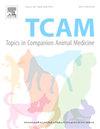比较无阿片麻醉方案和两种阿片麻醉方案对接受择期卵巢切除术的猫术中心血管反应和术后疼痛的影响:一项前瞻性、随机、盲法临床研究。
IF 1.3
3区 农林科学
Q2 VETERINARY SCIENCES
引用次数: 0
摘要
本研究比较了选择性卵巢子宫切除术的猫在无阿片类药物治疗方案和两种基于阿片类药物治疗方案之间对手术和术后疼痛的心血管反应。猫被随机分配到三个肌内术前用药法治疗:敏捷(dexmedetomidine 7µg / kg, n = 12),DEXMET (dexmedetomidine 7µg / kg + 美沙酮0.3毫克/公斤,n = 13)和DEXMOR (dexmedetomidine 7µg / kg + 吗啡0.3毫克/公斤,n = 14)。术前给予美洛昔康0.1 mg/kg皮下注射。麻醉由异丙酚诱导,七氟醚维持。术中测量心率(HR)和收缩压(SAP)。用药前(基线)和术后6小时使用格拉斯哥复合测量疼痛量表-猫(CMPS-F)和猫鬼脸量表(FGS)评估疼痛。CMPS-F评分≥5分给予抢救性镇痛。在所有组中,术中HR和SAP均升高,但未发生心动过速(HR > 200次/分)或高血压(SAP > 180 mmHg)。DEXMET组术后CMPS-F评分低于DEX组;DEX和DEXMOR组FGS评分高于DEXMET组。DEX组、DEXMET组和DEXMOR组分别对50%、23%和29%的猫进行抢救性镇痛(p < 0.05)。无阿片类药物与基于阿片类药物的技术在术后6小时内接受抢救性镇痛的优势比(95%置信区间)为2.86(0.76-11.43)。所有方案均允许在不加重心血管反应的情况下进行手术。在方案中加入美沙酮或吗啡降低了术后需要抢救性镇痛的几率。本文章由计算机程序翻译,如有差异,请以英文原文为准。
Comparison of the effects of an opioid-free anesthetic protocol with two opioid-based protocols on the intraoperative cardiovascular response and postoperative pain in cats undergoing elective ovariohysterectomy: A prospective, randomized, blinded, clinical study
This study compared the cardiovascular response to surgery and postoperative pain between an opioid-free protocol and two opioid-based protocols in cats undergoing elective ovariohysterectomy. Cats were randomly allocated into three intramuscular premedication treatments: DEX (dexmedetomidine 7 µg/kg, n = 12), DEXMET (dexmedetomidine 7 µg/kg + methadone 0.3 mg/kg, n = 13) and DEXMOR (dexmedetomidine 7 µg/kg + morphine 0.3 mg/kg, n = 14). Preoperatively, all cats received meloxicam 0.1 mg/kg, subcutaneously. Anesthesia was induced with propofol and maintained with sevoflurane. Heart rate (HR) and systolic arterial pressure (SAP) were measured intraoperatively. Pain was assessed before premedication (Baseline) and postoperatively for 6 h using the Glasgow Composite Measure Pain Scale - Feline (CMPS-F) and Feline Grimace Scale (FGS). Rescue analgesia was given for CMPS-F scores ≥ 5.
In all groups, HR and SAP increased intraoperatively, but tachycardia (HR > 200 beats/min) or hypertension (SAP > 180 mmHg) did not occur. Postoperative CMPS-F scores were lower in DEXMET than in DEX; FGS scores in DEX and DEXMOR were higher than in DEXMET. Rescue analgesia was administered to 50 %, 23 % and 29 % cats in groups DEX, DEXMET and DEXMOR, respectively (p > 0.05). The odds ratio (95 % confidence interval) of receiving postoperative rescue analgesia within 6 h for opioid-free versus opioid-based techniques was 2.86 (0.76-11.43). All protocols allowed surgery to be performed without an exacerbated cardiovascular response. Incorporating methadone or morphine in the protocol decreased the odds of requiring postoperative rescue analgesia.
求助全文
通过发布文献求助,成功后即可免费获取论文全文。
去求助
来源期刊

Topics in companion animal medicine
农林科学-兽医学
CiteScore
2.30
自引率
0.00%
发文量
60
审稿时长
88 days
期刊介绍:
Published quarterly, Topics in Companion Animal Medicine is a peer-reviewed veterinary scientific journal dedicated to providing practitioners with the most recent advances in companion animal medicine. The journal publishes high quality original clinical research focusing on important topics in companion animal medicine.
 求助内容:
求助内容: 应助结果提醒方式:
应助结果提醒方式:


